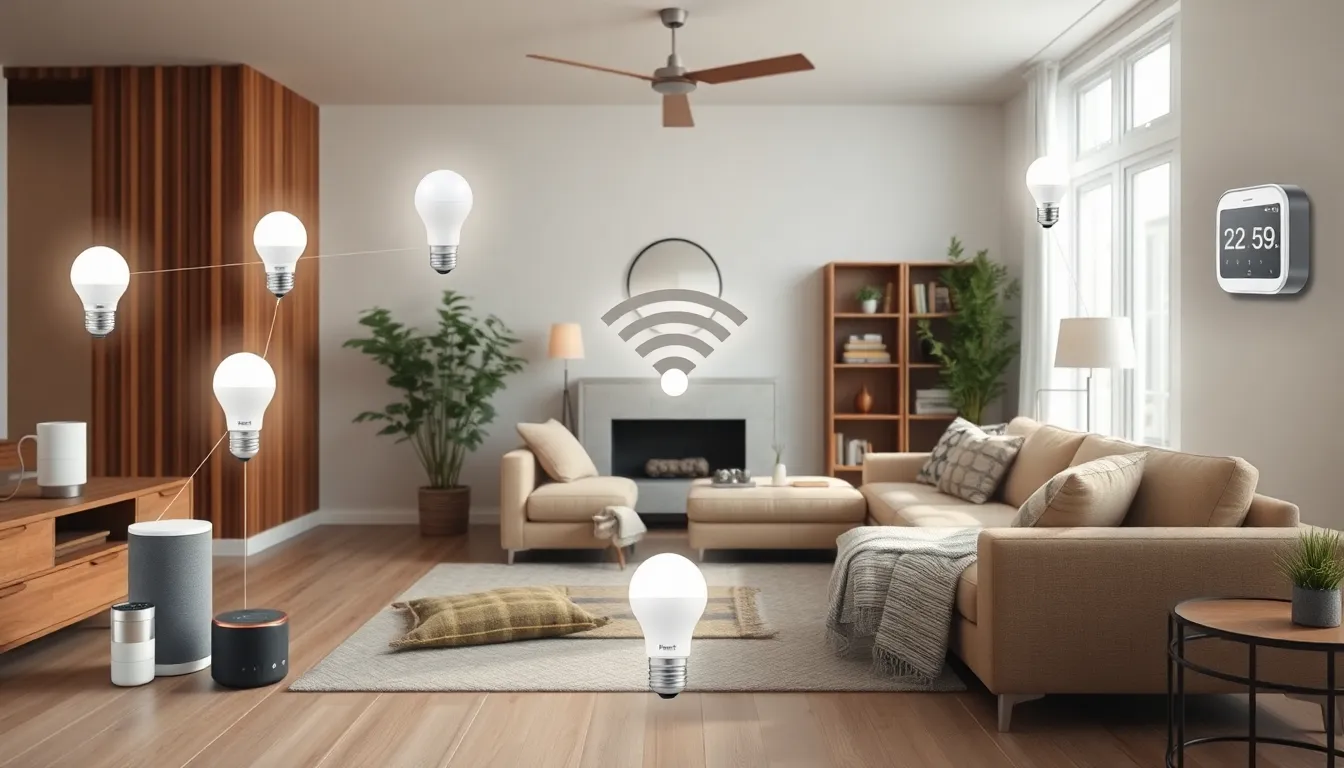Imagine walking into your home and having it greet you like a loyal butler. Lights flicker on, the thermostat adjusts, and your favorite playlist starts playing—all without lifting a finger. Welcome to the world of home automation networks, where technology transforms everyday living into a seamless experience.
These smart systems don’t just make life easier; they add a touch of magic to the mundane. With a flick of a smartphone or a simple voice command, homeowners can control everything from security cameras to coffee makers. It’s like having a personal assistant who never complains about coffee breaks.
As the demand for smart homes rises, understanding how these networks function becomes essential. Dive into the world of home automation and discover how it can simplify life while making it a whole lot cooler. Who wouldn’t want a home that practically runs itself?
Table of Contents
ToggleOverview of Home Automation Networks
Home automation networks enable seamless control of various smart devices within a house. These networks integrate devices such as lighting, thermostats, security cameras, and smart speakers, allowing centralized management. Users access the network through mobile apps or voice-activated assistants, enhancing convenience and accessibility.
Different protocols support home automation networks, including Wi-Fi, Zigbee, Z-Wave, and Thread. Each protocol provides unique advantages based on range, power consumption, and device compatibility. Wi-Fi allows direct internet connectivity, while Zigbee and Z-Wave operate on lower power, optimizing battery life in devices.
Installation of these networks varies, ranging from simple plug-and-play systems to more intricate setups requiring professional installation. It’s essential to evaluate existing infrastructure before making adjustments, ensuring compatibility with current devices.
Security remains a critical concern, as connected devices can be vulnerable to cyber threats. Utilizing encryption and secure passwords significantly mitigates risks. Regularly updating firmware for devices and employing firewalls further enhance this security.
Scalability marks an important feature of home automation networks. Homeowners can start with one or two devices and expand their networks as needed. Adding new devices typically involves minimal setup, allowing for gradual investment in smart technology.
The advantages of a home automation network extend beyond convenience. Improved energy management helps reduce utility costs through smart thermostats and lighting controls. Enhanced security through smart locks and cameras provides peace of mind for homeowners, making living spaces both safer and smarter.
Types of Home Automation Networks

Home automation networks can be classified into two main categories: wired networks and wireless networks. Each type offers distinct features suited for specific user needs.
Wired Networks
Wired networks provide reliable and stable connections for home automation. They typically utilize Ethernet cables to connect smart devices directly to the network hub. This setup minimizes interference, ensuring consistent performance. Short distances between devices and the central hub enhance speed and reduce latency. Common materials for installation include CAT5 or CAT6 cables. While installation may require professional assistance, the long-term benefits include improved security and the ability to handle larger data loads without degradation.
Wireless Networks
Wireless networks offer flexibility and convenience for home automation systems. Wi-Fi, Zigbee, Z-Wave, and Thread are popular protocols enabling devices to connect without physical cables. Each protocol varies in range, power consumption, and compatibility, catering to diverse requirements. Wi-Fi facilitates high-bandwidth applications with access to the internet, while Zigbee and Z-Wave excel in low-power, low-bandwidth scenarios for battery-operated devices. Homeowners appreciate wireless networks for their ease of installation and scalability, allowing for easy expansion and integration of smart devices.
Advantages of Home Automation Networks
Home automation networks bring significant benefits to everyday living. These systems streamline control over various devices, enhancing user experience and satisfaction.
Enhanced Comfort and Convenience
Control over lighting, temperature, and entertainment systems creates a tailored environment. Smart devices adjust settings automatically based on user preferences. Voice commands simplify interactions, making it unnecessary to walk to physical switches. Integrating multiple devices allows users to create customized scenes for different occasions. Scheduling features enable automated routines that match daily activities. Overall, the ease of managing various functions elevates overall comfort in the home environment.
Energy Efficiency
Home automation networks contribute to energy savings through optimized device management. Smart thermostats adjust heating and cooling based on occupancy patterns. Automated lighting systems turn off when rooms are unoccupied, reducing waste. Users can track energy consumption via mobile apps, enabling informed decisions about usage. Scheduling allows appliances to operate during off-peak hours, lowering electricity costs. By prioritizing efficiency, homeowners benefit from reduced energy bills and a smaller carbon footprint.
Improved Security
Enhanced security features provide peace of mind for homeowners. Smart cameras offer real-time monitoring, allowing users to check in remotely. Intrusion detection systems alert users to any unusual activity around their homes. Automated lighting can simulate occupancy, deterring potential intruders when homeowners are away. Smart locks enable keyless entry, making it easy to grant access to trusted individuals. These features combine to create a comprehensive security solution that safeguards homes effectively.
Challenges in Home Automation Networks
Home automation networks face several significant challenges. These can hinder user experience and overall effectiveness.
Compatibility Issues
Compatibility issues often arise due to varying communication protocols among devices. Protocols like Wi-Fi, Zigbee, and Z-Wave may not support every smart device, leading to integration problems. Users may find that certain devices work seamlessly while others do not connect at all. Additionally, manufacturers might prioritize proprietary technologies, limiting the interoperability of devices. These inconsistencies can frustrate homeowners looking for a unified smart home experience. Researching compatibility before purchasing new devices ensures better integration and smoother functionality.
Security Concerns
Security concerns pose a serious threat to home automation networks. Cyber threats can exploit vulnerabilities in connected devices, putting personal information at risk. Weak passwords or unencrypted data transmission heighten these security risks. Furthermore, many devices lack robust security measures, making them easy targets for cybercriminals. Homeowners must implement strong password strategies, regularly update device firmware, and utilize network security tools. Creating a secure home automation network should always prioritize protecting personal data and maintaining privacy.
Future Trends in Home Automation Networks
Emerging technologies are poised to redefine home automation networks. Increased adoption of artificial intelligence will drive smarter systems, enabling predictive analytics for energy management and user behavior. Homeowners may see devices that learn and adapt to individual preferences over time, creating personalized living environments.
The rise of 5G technology is set to enhance connectivity. Ultra-fast internet speeds will improve communication between devices, supporting more complex automation scenarios and allowing for real-time responses. Smart devices will send and receive data with minimal latency, increasing overall efficiency.
Interoperability among devices is gaining importance. Solutions that promote cross-compatibility will simplify integrations across different brands and protocols. Homeowners can expect devices from various manufacturers to work seamlessly together, reducing frustration and enhancing user experiences.
Sustainability trends will influence home automation networks. Eco-friendly devices and energy-efficient solutions are becoming essential features in new smart home products. Users may prioritize systems that optimize energy consumption and reduce carbon footprints as awareness of environmental issues grows.
Privacy and security enhancements will evolve to meet users’ concerns. Advanced encryption methods and biometric authentication options will protect personal data from cyber threats. Companies will likely invest in developing robust security measures to ensure user confidence in connected devices.
Adoption of voice-activated technology will continue to rise. Home automation systems integrated with smart assistants will become more intuitive and responsive, allowing for effortless control. The convenience of voice commands will attract a broader audience, encouraging more homeowners to explore automation options.
The convergence of home automation with other technologies, such as augmented reality, is anticipated. Users may interact with their smart environments through AR interfaces, providing immersive experiences that enhance daily living. These innovations will pave the way for novel user interactions with automated systems.
Home automation networks are transforming how people interact with their living spaces. By integrating smart devices into daily routines, homeowners can enjoy unparalleled convenience and enhanced security. As technology evolves, these systems will continue to adapt and improve, offering even greater efficiency and user-friendly experiences.
The future promises exciting developments in areas like artificial intelligence and 5G connectivity, making smart homes more intuitive and responsive. With an emphasis on sustainability and interoperability, the landscape of home automation will only grow richer. Embracing these innovations can lead to a more comfortable and secure home environment, ultimately enhancing the quality of life for everyone.


